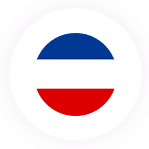When we refer to the Slavs, we are talking about a very ethnically diverse group of people whose many languages are ultimately derived from the Indo-European family, specifically the subfamily of Slavic. Subdivision examples within the Slavic subfamily include those languages which are likely most familiar to you: Russian, Ukrainian, Polish, Czechoslovakian, Belarusian, Bulgarian, Bosnian, Serbian, Croatian and Slovenian. Slavic people not only speak languages derived from the same essential place, but they also share cultural traits and ancient historic backgrounds before their once cohesive people ultimately fragmented. Slavic people represent over half of the inhabitants of the European continent, specifically located in Central and Eastern Europe (and Russia which extends to Asia) spreading down to the Balkans.
It’s actually a testament to the Slavic people that they even survived, since the ancient Slavs were up against some pretty formidable enemies. It seemed they were often faced with one potential adversary or another – such as the fearless Scandinavians who came from the north, the warrior culture of the Germanic tribes from the west, the powerful Byzantine Empire to the south and the nomadic or Asiatic tribes from the east. Yet despite the fact that the ancient Slavs have never been viewed by history as one of the “great warrior” societies, they still managed to not only stay alive, but actually prosper. Instead, they have a history of co-mingling with the interloping populations and learning from them. They generally co-existed peacefully while maintaining their own uniform culture. Some etymologists believe that the names Slav/Slavic came from their own Slavic language, from slovo which simply means "word" in reference to their common language, in essence, people who understand each other and are tightly connected.
The original Slavic homeland is up for debate, but generally believed to be descended from tribal cultures in or around Belarus, Poland, or Ukraine, and then expanded to the aforementioned territories we mentioned above. During and after the decline and fall of the Roman Empire, a migration period was well under way as barbaric tribes went searching for new places to conquer and establish their own societies. Germanic tribes such as the Goths, the Vandals, the Franks and the Lombards were part of this migration. From the east came such tribes as the Huns. The Slavs soon followed, settling in territories largely abandoned by the migrating tribes and calling it their own. The thing about the Slavs is once they carved out a place to call home, it generally became theirs for good.
The Byzantines considered the Slavs to be a backwater culture and too unsophisticated to even give a minute’s thought, but they grossly underestimated these people. Behind their simplistic societies, the Slavs were better organized than first met the eye, and underneath lay volcanic energy and an unmistakable fierceness. Extricating them from their land was not likely to happen. It’s true they were better agriculturalists and farmers than they were warriors or army tacticians. But herein lay their secret. Better food production equals an increase in population. An increase in population means more men to protect their lands and fight their wars. What they lacked in the “Art of War”, they made up for in numbers. Plus, the Slavic people were an egalitarian society, fairly decentralized and super independent, so they were extremely difficult to weaken. There was no one King or ruler that could be defeated or bribed. Therefore, the Slavic people have been able to maintain their territories almost without exception.
In less than 200 years between the 5th and 7th centuries, the Slavic people were a culture that succeeded in occupying half of Europe, proving that you don’t have to be the biggest bully of the lands, but just uniformly smart in how you achieve and hold your position. How can we not take out hats off to these resourceful, efficient and effective people? After forming their permanent settlements, the Slavs then went about assimilating local populations and generally Slavicizing non-Slavic people.
In modern times, at the end of the 19th century, there were four free Slavic states: the Russian Empire, Bulgaria, Serbia and Montenegro. At this point, while Slavic people comprised almost half of the Ausro-Hungarian Empire, they were largely denied a voice. This changed after World War I when the independent states of Czechoslovakia, the Second Polish Republic, and the Kingdom of Serbs, Croats and Slovenes were established. An artistic movement known as “Pan-Slavism” also took place in the 19th century meant to unite those of Slavic origin, but the concept was hijacked as an ideology by the Russian Empire to justify their land grabs and to suppress other ethnic Slavs (mainly Poles and Ukrainians). It then became connected to Russian Imperialism and 20th century communism in general.
Today, the global population of Slavic people is around 400 million. More than one quarter of those people live in Russia. Over 100 million are divided between Poland and the Ukraine. Other Slavic ethnic groups include Czechs (11 million), Serbs (10 million), Bulgarians (10 million), Belarusians (10 million), Croats (8 million), Slovaks (7 million), Bosniaks (3 million), Macedonians (3 million), and Slovenes (2.5 million). In the United States, the majority of people who make up the Slavic-descended population are Poles (10 million). The Polish populations mainly settled in the northern mid-western states (Wisconsin, Michigan and Illinois) and the New England states (Connecticut, Massachusetts, New Hampshire).
Here is a list of the currently most popular names in some Slavic nations:
Russia (2011)
BOYS: Daniil, Maxim, Artyom, Ivan, Alexander, Kirill, Dmitry, Nikita, Andrey and Mikhail
GIRLS: Sofiya, Anastasiya, Dariya, Mariya, Polina, Yelizaveta, Anna, Viktoriya, Valeriya and Alisa
Poland (2010)
BOYS: Jakub, Szymon, Kacper, Filip, Michał, Mateusz, Bartosz, Wojciech, Adam, and Wiktor
GIRLS: Julia, Maja, Zuzanna, Lena, Wiktoria, Amelia, Oliwia, Aleksandra, Natalia, Zofia
Ukraine (2010)
BOYS: Oleksandr, Maksym, Artem, Danylo, Mykyta, Vladyslav, Denys, Andriy, Dmytro and Kyrylo
GIRLS: Anastasia, Sophia, Mariya, Anna, Dariya, Viktoria, Polina, Kateryna, Yelysaveta and Olena
Czech Republic (2011)
BOYS: Jakub, Jan, Tomáš, Lukáš, MatÄ›j, Matyáš, Adam, Filip, VojtÄ›ch and OndÅ™ej

